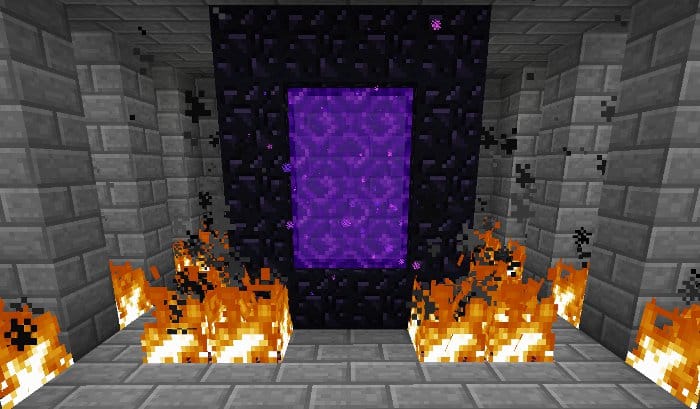
Nether Portal
Nether portals are used to gain travel to and from the Nether and are build using obsidian. A minimum of 10 obsidian blocks are required to build it, though most people use 14 as it looks better. A Nether portal is build by placing the obsidian blocks in a 5×4 rectangle. The corners can be left out, which saves you 4 pieces of obsidian.
Once the portal is activated, a player will only be teleported to the Nether if the player stands inside the portal for 4 seconds. Moving out of the portal before this time will stop the teleportation process.
A new portal will be created in the other dimension the player is traveling to, unless a portal is already available in the surrounding area.
Activation
A portal is activated by setting the top of a bottom block on fire. This will immediately create a purple portal which can be entered.
The type of fire used to activate the portal doesn’t matter, though the easiest methods are flint and steel and fire charges.
Fire charges fired by dispensers are also capable of activating a portal, but because dispensers shoot fire charges in random angles, activating a portal can often take a while.
Flammable blocks can also be used to activate the portal. By simply placing a block on top of a bottom block and getting it to catch fire, either by setting it on fire or by placing lava near it, the block will catch fire and activate the portal once the block is destroyed.
This method can take a few tries and is usually only used in custom adventure maps.
It’s impossible to activate a portal while in the End, the bottom blocks will simply catch fire and stay lit for a while.
A ghast’s fireball can both activate and deactivate a nether portal, which can both be a pain and a life saver while in the Nether without a flint and steel.
Other explosions, like exploding beds and creepers, can also deactivate a portal, but these explosions cannot activate it.
Portal Properties
When a player teleports using a portal, a new portal will be created it in the other dimension of there’s no other portal available.
This shape of the original portal does not affect the newly generated portal, which will always be made out of 14 blocks of obsidian. This means portals can be used to create an infinite amount of obsidian blocks, though it’s a little time consuming to farm obsidian this way.
A portal can sometimes generate in the air, in this case a small 2×1 platform on each side of the portal will be generated with it, which should prevent players from falling into lava when they step out of a portal.
It’s always advised to step out of a portal with caution, it’s close to impossible to see your surroundings while in the purple portal effect.
An activated Nether portal will have a purple, force field-like area inside it. This purple portal will emit odd sounds which are quite loud when you’re close by.
These sounds often annoy players, who will usually build a Nether portal far away on a mountain peek or deep down in a dungeon.
The sound can be heard up to 15 blocks away, though the further you are the fainter it’ll be.
This purple portal area also emits a light of light level 11. This light is strong enough to prevent mobs from spawning up to 4 blocks away from it and adds a creepy effect to any area with a portal.
It’s impossible to activate a portal with a larger or smaller portal space than 3×2. However, it is possible to place the active purple portal blocks by using mods, which allows for the creation of tiny or huge Nether portals.
A single active portal block will allow you to travel to the Nether.
Only obsidian and portal blocks can be placed next to other portal blocks, placing anything else will cause the portal block to dissapear.
Portal Travelling
The distance you travel in the Nether is multiplied by 8 in the Overworld (or by 3 if you play the Xbox version). This means you can travel huge distance in a few minutes by simply connecting a few portals together.
However, setting up a large network can be a bit tricky, as Nether portals are not connected to each other, but rather look for any portal close in range.
This is done through a few calculations based on the coordinates of the lowest 2 active portal blocks.
First the destination is calculated by either dividing or multiplaying the current X and Z coordinates with 8, depending on whether a player travels to or from the Nether. The calculation is done with coordinates that have been rounded down to the nearest integer. So X = 35.87 and Z = – 45.23 becomes X = 35 and Z = -46.
Then the game will try to find an active portal in a 128 block radius around the destination coordinates. If one or more active portals are found, the player will be teleported to the nearest portal available.
Note that active portals above level 127 will not be looked for.
If an active portal cannot be found, a new one will be generated. The game will first try to find a valid space for the portal to spawn in, preferablly facing the same direction as the original portal. If such a place cannot be found, the portal will be generated at the destination coordinates. Any blocks around the portal will be turned into air.
By using these calculations and rules, players can easily create a system of portals to travel large distances in the Overworld.
Just keep in mind that:
– The distance has to be divided or multiplied by 8, but only the horizontally (X and Z axes) when you want to calculate where you end up.
– Portals will always teleport you to the closest, active portal within 128 blocks of the destination. Active portals above a height level of 127 will not be looked for.
